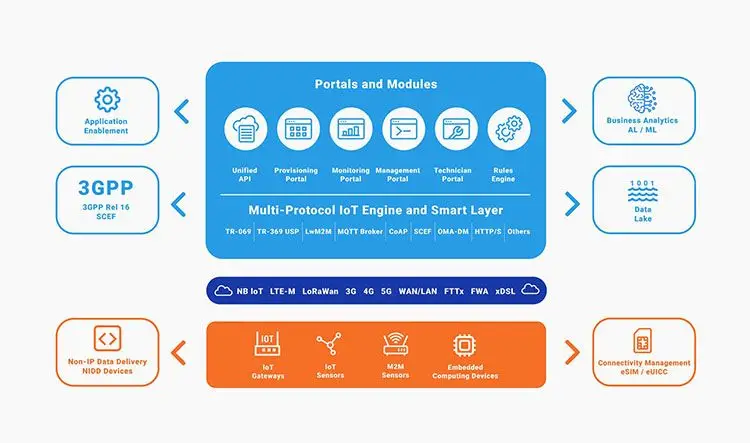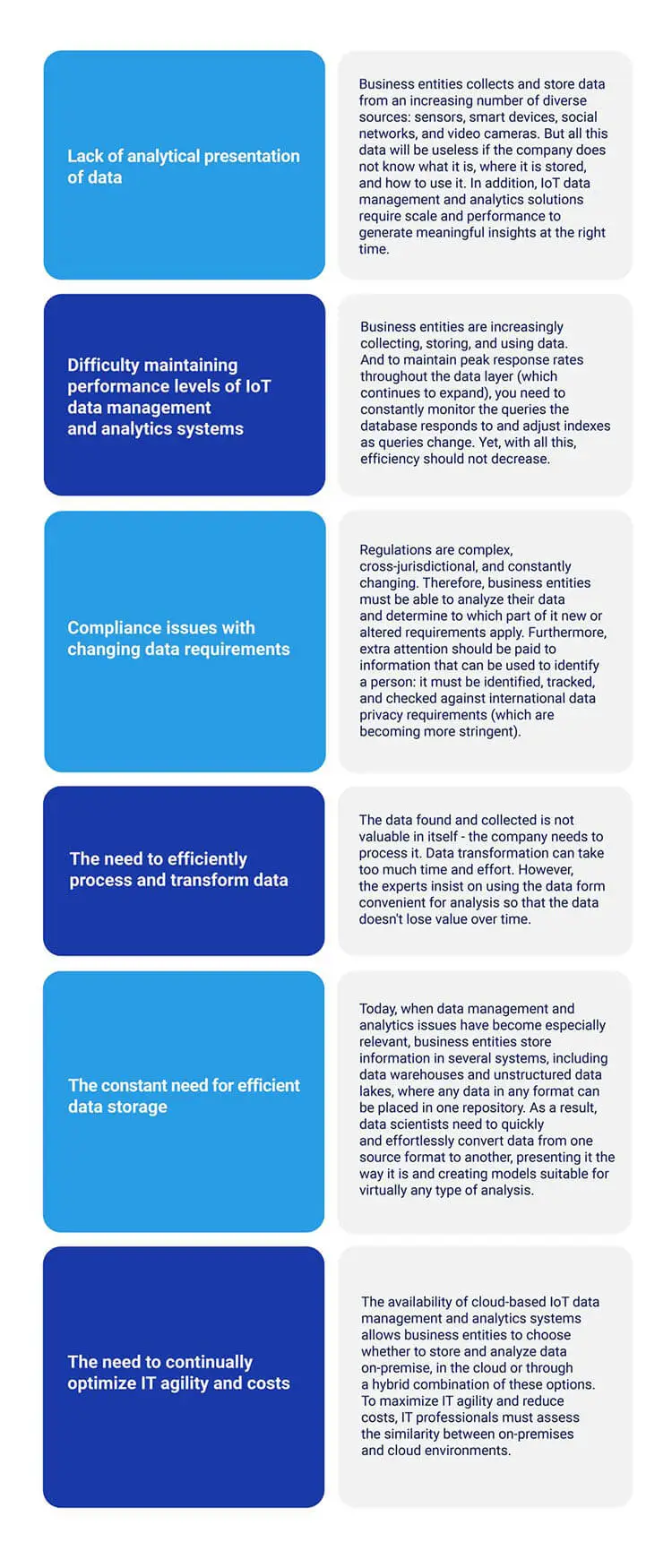IoT
IoT data management and analytics for manufacturers

List of Content:
● IoT data management and analytics for manufacturers
● The IoT data management: strategies and solutions
● Challenges of implementing predictive analytics in IoT
● Why are IoT data management and analytics critical?
● Potential of IoT device management
● IoT data management vs. traditional database management systems
● Big Data management
● Data privacy and data governance principles
● What is IoT data management and analytics? Practical recommendations
● Challenges for IoT data management and analytics
Data management and analytics for IoT manufacturers
The Industrial IoT refers to the billions of industrial devices - factory machines to aircraft engines - filled with sensors. Sensors interact, collect data locally, store data, and exchange data via wireless sensor networks or Wi-Fi. The advent of miniaturized, low-cost smart objects, like sensors and broadband wireless networks, now means that each IoT sensor, even the smallest connected devices, can be connected to the network. And given the level of current digital intelligence that allows them to be monitored and controlled, as well as share their status and communicate with other devices. Furthermore, all this IoT device data can be collected and analyzed to improve the efficiency of business processes. The endgame IoT platforms leads to better control over the business and more straightforward ways to find new revenue streams.
The IoT Data Management: Strategies and Solutions
Industrial IoT analytics is important because of its potential for faster and more efficient decision-making. The changes that IoT data analytics and data management can bring are a part of the overall digital transformation that many business entities are working on. By providing highly detailed real-time data, IoT data analytics and IoT app development services can help business entities better understand their business processes and, by analyzing the data coming from sensors, can make their operations more efficient and even unlock new revenue streams. The Industrial Internet of Things can also give businesses an insight into the wider supply chain, allowing companies to coordinate and improve efficiency.
Here are the essential components of a complete IoT data management and analytics solution that both manufacturers and business people should know about:
● Preparing machine-readable data: receives, structures, sorts, filters, transforms, modern IoT data management and analytics, groups, analyses, and broadcasts data obtained from "things" - big and small - regardless of whether they come from a fitness bracelet or SDH network monitoring equipment. It prevents “descriptive analytics.” Depending on the type of this data, they can either be redirected to applications for which they are of the most significant value or directly processed by operators of the platform and vertical solutions built on its basis.
● Data normalization is a crucial part of the IoT data management strategy. The optimal IoT data analytics system is developed with individual analytical modules without any idea of the physical meaning of the data they will process. Instead, device drivers abstract the received values based on the characteristics of communication protocols. This information is then fed into a single data model, where it is scaled and transformed for consistency. After that, the data can freely move between any platform modules.
● Big data: The flow of information in the IoT can be overwhelming. Hundreds of thousands of transactions within data management in IoT, every second at the moment, is "the peak load" for a large financial institution, while for an oil refinery, processing this amount of metrics is a typical work situation. All this IoT data requires an optimized framework to achieve similar amounts of data processing on a single server and much better performance when using a cluster of servers connected through the distributed infrastructure (so-called "fog computing" data management framework.)
● Domain-specific languages: Successful IoT data management implies a specific IoT architecture. For example, an internet of things app development process typically involves multiple layers of architecture, including sensors, gateways, cloud storage, and data analytics platforms. The optimal architecture should implement query, expression, and process (as well as some others) languages explicitly designed for the "natural" understanding of the normalized data circulating in the system. In addition, the built-in development environment and debugger greatly simplify data processing, without which it is currently challenging to imagine a corporate-level monitoring and control system.
● Machine Learning: Discovering relationships between real-time data, historical data, and recently collected data is a critical feature of successful IoT platforms. More than 20 algorithms and hundreds of parameters will satisfy any data analyst's expectations. In addition, the visual process editor allows you to set up, train, evaluate and manage models according to the given logic, while incremental training and the ability to stream data complete the picture.
● Real-time analytics: Systems that are particularly good at analyzing time series are the most common data type in IoT. This allows you to detect anomalies, predict the behavior of graphs and classify time series, regardless of the physical meaning of the information and the number of metrics in the data array. In addition, support for working with streams provides seamless processing of large amounts of information that will never fit in memory.
● Event Management: The capabilities of the event monitoring and processing module include filtering, sorting, aggregation, de-duplication, masking, correlation, validation, enrichment, and root cause search. Most analytic modules support event activation and can be triggered by events received from external IoT sources or user-created object and process models.
● Dashboards for data analytics: From the visual part of the IoT platform, as a rule, nothing more is expected than counters, maps, tables, and graphs. Modern IoT data management and analytics can compete with the best representatives of business intelligence systems in creating statistical, analytical, and data mining interfaces. As a business owner, you can implement AI and IoT technologies simultaneously to optimize operations. You can also drill down on accumulated data, discover new relationships, and find ways to save energy consumption or equipment downtime.
● Focus on results: Although the platform does not bring anything to your business, it allows you to focus on generating profits instead of solving infrastructure problems. The development and deployment of a modern IoT data management and analytics-based solution in a customer's infrastructure usually take only a few months. At the same time, the actual economic effect is visible already in the first weeks of implementation.
● Digital Twins: The object and process modeling engine allows you to create digital twins of physical assets and services. Models use business rules to make decisions when important events occur automatically. Each model can be attached to devices, data sources, or other models lower in the digital enterprise hierarchy.
Challenges of Implementing Predictive Analytics in IoT
As world statistics show, about 80% of analytical projects in this direction remain unsuccessful and are not being exploited. IoT product development process is still a yet-to-be fully established and commonly accepted idea. This may be due to both technological risks and organizational problems. In addition, various barriers hinder the successful implementation of predictive analytics. The most important of them, according to the experience of Factory5, can be divided into three groups:
1. Data. The model's performance critically depends on the availability and quality of the data obtained. At the same time, no data is needed, but suitable according to specific criteria.
2. Business processes. It is essential to understand who is doing what when the "red light" lights up. And the results should influence maintenance and repair processes.
3. Expertise. It is needed both when creating and interpreting the model - "bare mathematics" does not work well. Often vendors have their own closed and universal algorithms to cover the maximum possible range of equipment. The system for each sensor compares the actual value with the calculated one at the current time. Then the diagnostic rules analyze the value of the total deviation and the contribution of each sensor's variation. Forecasting is usually limited. This is also due to the specifics of the models. For example, the value of an individual sensor can be predicted for a short period.
Why are IoT Data Management and Analytics Important?
Collecting, storing, and visualizing raw data is just the beginning of any significant IoT project. The economic effect is achieved by management decisions to optimize existing processes and bring new products and services to the market for end customers. Technically, the above is achieved by aggregating, processing, and in-depth analyzing data received from devices. However, for each significant solution, these operations will be unique - optimizing the storage space of harvested crops is fundamentally different from orchestrating transactional data in smart grids or managing a forklift fleet. Analytic capabilities range from simple emergency alerts to advanced data processing with machine learning modules to detect anomalies and predict events such as turbine failure. Years of presence in the market and thousands of projects implemented by our partners in all vertical markets have allowed us to ensure that the platform has the necessary set of tools for each case.
Potential of IoT Device Management
IoT solutions require automated zero-touch device control at the scale of millions of things. Therefore, predictive analysis and proactive maintenance are critical success factors. In addition, IoT Device Management should automatically classify devices into states that depend on the context of use. If not, they are ineffective solutions for lame ducks. (с) Kurt Peterhans.
IoT device management is a process that helps business entities manage their network infrastructure and endpoints remotely. With the implementation of the IoT Device Management Solution, decision-makers can monitor the performance and health of devices on their network and remotely configure and update them.
Customer experience gives them better visibility into the status of their devices. The IoT space is rapidly evolving and has incredible potential to impact digital life. In the meantime, effective IoT device management is fundamental to any successful IoT solution - provision, authenticate, configure, control, monitor, and maintain IoT devices at scale. IoT solution incorporates future-ready modules and functionalities for successfully deploying, monitoring, and managing IoT devices for any vertical.

IoT device management refers to the combination of access control, quality of service, and data security systems for IoT devices. This is a critical feature for any IoT management and analysis system. Several features are commonly included in IoT device management solutions, such as:
● Identity and Access Management: This helps ensure that only authorized users can access device data.
● Quality of Service: This ensures that devices can perform optimally and provide the required level of service.
● Data Security: This helps protect valuable data from unauthorized access.
IoT Data Management vs. Traditional Database Management Systems
Today, business entities need a solution that can provide efficient, unified management of diverse data at a single level. IoT data management and analytics systems are built on top of management platforms. They can include traditional databases, data lakes and warehouses, big data management systems, analytics, and more.
All these components interact, forming a single platform for working with data. It provides IoT data management and analytics tools used in enterprise applications and analysis tools and algorithms for processing this data. Although modern tools make it possible to automate many management tasks, most database deployments are so large and complex that the intervention of a database administrator is still necessary. This increases the likelihood of errors. Reducing the need for manual IoT data management and analytics is one of the main goals of the new IoT technology for data management, the autonomous database.
Cloud platforms provide an opportunity to quickly scale the number of resources used without extra costs, thus growing in popularity among business users. In addition, some of these platforms are cloud services, providing additional cost savings for business entities.
Big Data Management
The term big data should be taken literally: it means a large, tremendous amount of data. However, big data is diverse and collected faster than traditional data. For example, imagine how much data a social network like Facebook generates daily. The quantity, variety, and speed of such data are of particular value to businesses. However, managing big data is also tricky. The volume of data coming from disparate sources (cameras, social networks, audio recordings, IoT devices) is constantly increasing, inevitably leading to the emergence of big data management and analytics systems. These systems have three main areas of application:
● Big data integration - working with data of different types (from batch to streaming) and converting them for subsequent use;
● Big data management - efficient, reliable, and secure storage of data in a lake or data warehouse, as well as its processing (often using an object storage system);
● Big data analytics - extract new, actionable insights using analytics tools, including graph analytics, and build models with machine learning and ai-powered visualizations.
Business entities are using big data to improve and accelerate product development, proactive maintenance, customer experience, security, operational efficiency, and more. As big data grows, new opportunities open up for us.
Data Privacy and Data Governance Principles
The GDPR, a regulation, has guided the collection, unification, and use of personal data in the EU since May 2018. To protect data, it regulates seven critical principles for managing and processing personal data. According to these principles, when initiating data access, or working with data, legality, integrity, transparency, accuracy, integrity, confidentiality, compliance with restrictions, and storage requirements, must be ensured, among other things.
The GDPR and similar laws, such as the California Consumer Privacy Act (CCPA), are changing how we manage data. These requirements have shaped data protection standards that give individuals control over their data and its use. In practice, this means that consumers become the data owners and can sue if business entities collect data about them without informed consent, fail to maintain adequate controls over how data is used and hosted, or fail to comply with data deletion or portability requirements.
What is IoT data management and analytics? Practical recommendations
Data management: To successfully manage the challenges of data management, you need a comprehensive, well-thought-out set of best practices. Which recommendation to choose depends on the type of data and the industry, but the following practical recommendations will help you deal with some of the most significant challenges facing businesses today.

Challenges for IoT Data Management and Analytics
Today's data management and analytics challenges are driven primarily by the exponential growth of data and the accelerating pace of business. Business entities have access to more diverse data, which is processed faster and in more significant volumes. This creates a need for effective management tools. Here is a list of some of the toughest challenges business entities face today.
- Lack of analytical presentation of data Business entities collects and store data from an increasing number of diverse sources: sensors, smart devices, social networks, and video cameras. But all this data will be useless if the company does not know what it is, where it is stored, and how to use it. In addition, IoT data management and analytics solutions require scale and performance to generate meaningful insights at the right time.
- Difficulty maintaining performance levels of IoT data management and analytics systems. Business entities are increasingly collecting, storing, and using data. And to maintain peak response rates throughout the data layer (which continues to expand), you need to constantly monitor the queries the database responds to and adjust indexes as queries change. Yet, with all this, efficiency should not decrease.
- Compliance issues with changing data requirements Regulations are complex, cross-jurisdictional, and constantly changing. Therefore, business entities must be able to analyze their data and determine to which part of it new or altered requirements apply. Furthermore, extra attention should be paid to information that can be used to identify a person: it must be identified, tracked, and checked against international data privacy requirements (which are becoming more stringent).
- The need to efficiently process and transform data The data found and collected is not valuable in itself - the company needs to process it. Data transformation can take too much time and effort. However, the experts insist on using the data form convenient for analysis so that the data doesn't lose value over time.
- The constant need for efficient data storage Today, when data management and analytics issues have become especially relevant, business entities store information in several systems, including data warehouses and unstructured data lakes, where any data in any format can be placed in one repository. As a result, data scientists need to quickly and effortlessly convert data from one source format to another, presenting it the way it is and creating models suitable for virtually any type of analysis. The need to continually optimize IT agility and costs The availability of cloud-based IoT data management and analytics systems allows business entities to choose whether to store and analyze data on-premise, in the cloud or through a hybrid combination of these options. To maximize IT agility and reduce costs, IT professionals must assess the similarity between on-premises and cloud environments.
Conclusion
IoT data management and analytics is the accumulation, storage, and updating of data and information retrieval. In the era of global digitalization, database management is becoming one of the most essential success factors for any business. Any enterprise owns a vast amount of data (data about the structure of production, about manufactured goods, even about raw material suppliers and buyers of finished products,) changes in the market for products in the country and the world, graphs of changes in consumer demand in retail trade, and much more.
One of the main problems in full-fledged IoT data management and analytics is their generation and storage in embedded systems. Any manager's dream is to enter a single system, set criteria, press a button, and get a report from which he will see precisely what he needs at a particular moment to make a decision. But, in fact, the decision-making process takes much longer - different structural divisions of the company prepare extra information from various sources, which takes time and does not guarantee the absence of errors.
If micro and small businesses can do without introducing expensive IoT solutions, then a large corporation without such analytics can lose market positions and reduce capitalization. Large retail chains were among the first to use various system solutions for collection, storage, and analytics. Database management allows chains to manage inventory - depending on customer demand in a particular month, day, and even specific time of day, to be flexible in scheduling the work of store employees, not to lose time ordering the identical product from a particular supplier, and, on the contrary, to instantly change the supplier when the prices for goods from another decrease.
Data management supports the processes of every successful business entity across all industries. With more access to more data and analytics, it becomes possible to take advantage of more opportunities, ask more questions, and solve more problems.
The issues of IoT data acquisition, data processing, data management and analytics, which were previously given secondary roles among the tasks under consideration that can affect the work of enterprises, have recently come to the fore more and more often. Data is becoming a valuable resource in the age of digitalization and the widespread use of automated systems. Therefore, a frivolous attitude towards it does not bode well for the sustainable operation of organizations and even more so for their development.
Looking for an experienced partner in building a top-notch IoT data management system? Contact our team for a consult.
If you’re implementing a modern IoT data management and analytics system for your business, reach out to our IoT team. We’ve got just the expertise to help!
